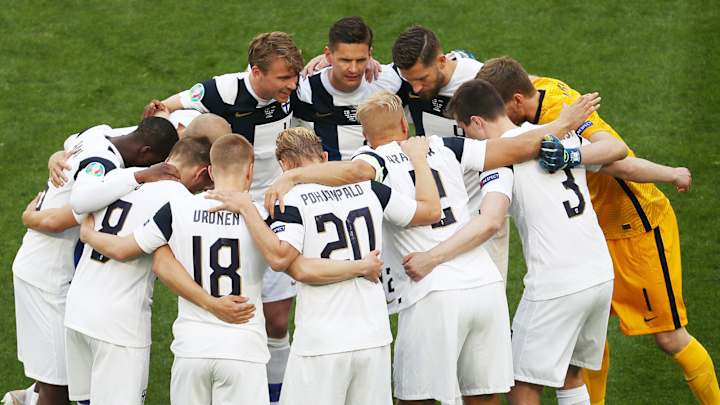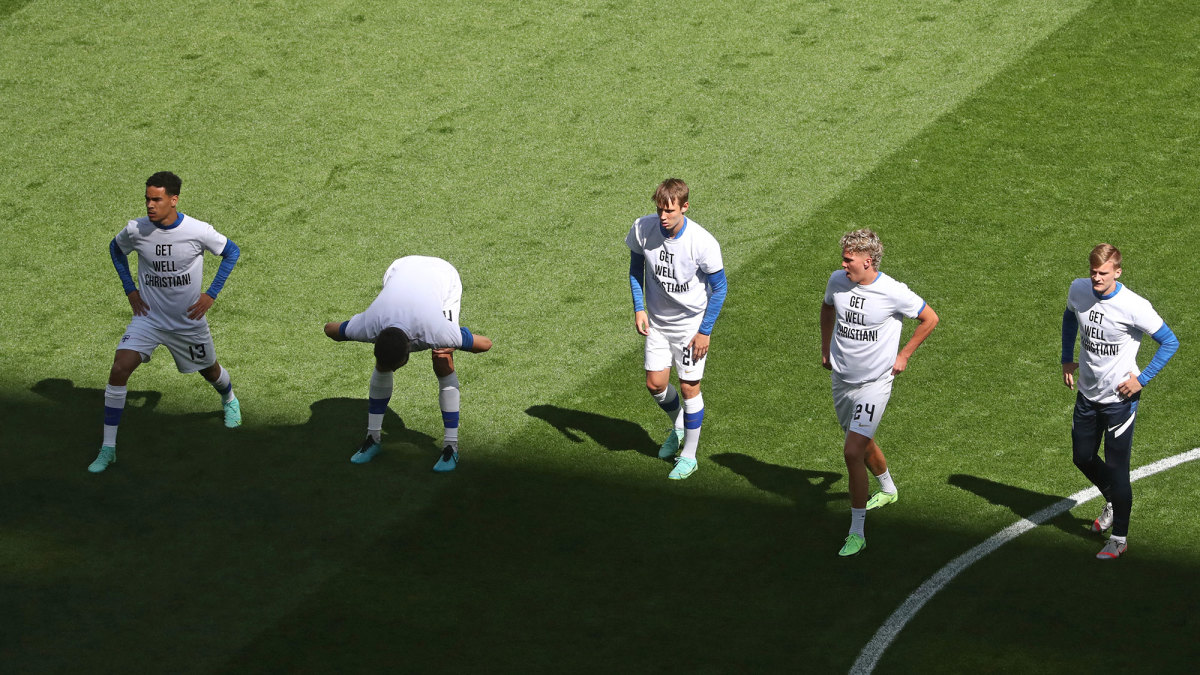Finland's Feat: Reaching Euro 2020—and Having Hope for More

A week ago, Finland would probably have taken this position: take a point from its final group game against Belgium, and it should qualify for the last 16 at Euro 2020. In its first tournament, that would be a remarkable achievement. But, having beaten Denmark over the weekend, following up with a 1–0 defeat to a largely uninspired Russia side playing on home soil on Wednesday inevitably felt anti-climactic.
Saturday was a strange day for Finland. Under normal circumstances, the momentous occasion would have been cause for celebration. Winning should have made it an unforgettable day—and it was unforgettable, but not for the 1–0 victory. The image that will remain with everybody involved was not of Joel Pohjanpalo’s headed winner, but of Christian Eriksen lying limp on the pitch having suffered a cardiac arrest. The contrast between the glee with which Finland’s players sang their anthem and Pohjanpalo’s muted celebration of his goal was striking.
“Football was not the most important thing that day,” Finland captain and midfielder Tim Sparv said.
Finland’s players and fans behaved impeccably in hugely difficult circumstances—the scenes of the fans engaging in a call and response of “Christian” and “Eriksen” with Danish fans were enormously moving—and the players warmed up before the Russia game in T-shirts bearing the message, “Get well, Christian!”

Denmark coach Kasper Hjulmand had spoken, in the aftermath of the Eriksen incident, of players having to “dare” to play with “joy and aggression.” This, in a sense, was Finland’s true first game in a major tournament, a game in which its players could just think about the match itself without the immediate pressure of a far greater concern.
The temptation is to ask whether Finland could be the Iceland of Euro 2020 and, although there are certain similarities between the emergence of the two nations, there are also major differences. Both, for instance, have focused on the construction of all-weather pitches and on providing professional coaching for players of all ages, raising the general level.
But Finland has a population of 5.5 million, while Iceland’s is just around 350,000. In that sense, the comparison should arguably be to Denmark, although there is a lot of catching up to be done. Denmark was an early adopter of the game, taking silver at the 1908 Olympics, and it’s a measure of how far behind Finland is that total player sales from the Danish league last season had a value 20 times that of the Finnish league.
And while Iceland’s progress to the quarterfinals at Euro 2016 was based on the greatest generation of players the country had ever produced, this Finnish squad almost certainly isn’t as good as the one of 20 years ago that featured the likes of Jari Litmanen, Sami Hyypiä and Antti Niemi. (It’s easily forgotten that David Beckham’s last-minute free kick against Greece that qualified England for the 2002 World Cup was only relevant because Finland drew 0-0 away to Germany the same day.)

The difference is down partly to the fact that the expanded format of the Euros offers an opportunity to more countries, but also a change of mentality. As Eero Laurila, a former journalist who is now a coach with third-division Finnish side Espoon Palloseura, points out, Finland used to specialize in individual sports: javelin, long-distance running, cross-country skiing and ski jump. That began to change with ice hockey, particularly after the “whiteboard revolution” that began to instill more integrated tactics led to an improvement in results, culminating in the world title in 2011, and has now been carried into football.
The result is a tight-knit, highly organized side, and it looked as though it had gotten off to a perfect start in St. Petersburg on Wednesday on its quest to make it two wins in two games. With Finland pressing in a way it hadn’t against Denmark, Jukka Raitala robbed Mario Fernandes on the right and crossed for Pohjanpalo to head powerfully past Matvei Safonov. There was nothing muted about his celebration this time, but a linesman’s flag ruled the goal out.
Thereafter it was back to the more expected Finnish approach, sitting deep, looking to absorb pressure and using Teemu Pukki on the break. Russia dominated possession without looking especially dangerous until, just before halftime, Aleksei Miranchuk exchanged passes with Artem Dzyuba and, with very little backlift, guided the ball into the top corner—a rare moment of quality after a largely ordinary half.
What a sensational strike from Aleksei Miranchuk! #RUS takes the lead on #FIN just before halftime at #EURO2020
— SI Soccer (@si_soccer) June 16, 2021
(via @ESPNFC)pic.twitter.com/eKBWyUTIZm
Finland had far more of the ball in the second half, but with Pukki far from fully fit and forced off after 76 minutes there was very little cutting edge, and the only real chance of the half fell the way of Russia's Daler Kuzyaev, his low shot being well saved by Lukáš Hrádecký.
It may have been a reality check for Finland, but just being at the Euros is a major achievement on its own. And while taking even a point off Belgium will be a major challenge—Finland did beat France in a November 2020 friendly, for what it's worth—there is still hope for its stay on a major stage to be extended.
More Euro 2020 Coverage:
